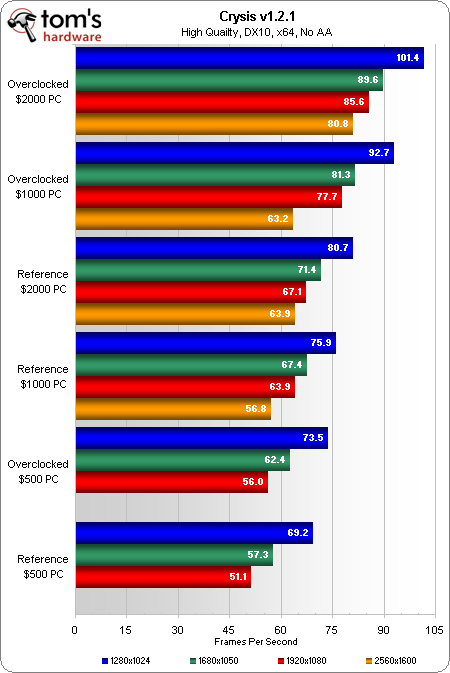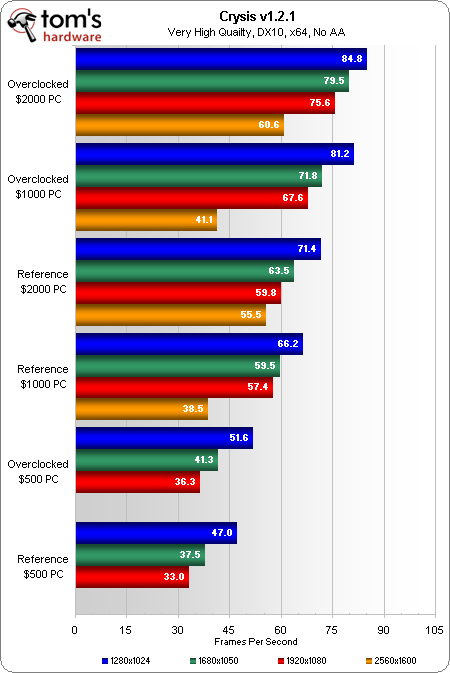System Builder Marathon, June 2011: Value Compared
Deals
By
Thomas Soderstrom
published
Benchmark Results: Crysis

It doesn't make much sense to test the $500 machine at 2560x1600, since a 30" screen costs at least two times what the PC itself would run. More likely is that a gamer would buy a value-oriented system for resolutions of up to 1680x1050. And that's where we see this system show most competitively.


The $1000 build performs admirably up to 1920x1080 at our higher Crysis settings, stumbling only slightly at the $200 machine’s 2560x1600 target resolution.
Current page: Benchmark Results: Crysis
Prev Page Benchmark Results: SiSoftware Sandra Next Page Benchmark Results: F1 2010Stay On the Cutting Edge: Get the Tom's Hardware Newsletter
Get Tom's Hardware's best news and in-depth reviews, straight to your inbox.
TOPICS
Thomas Soderstrom is a Senior Staff Editor at Tom's Hardware US. He tests and reviews cases, cooling, memory and motherboards.
37 Comments
Comment from the forums
-
jricha51 Would it be possible for me to run the same benchmarks? I have a AMD Athlon 64 X2 5600+ Windsor 2.8GHz Socket AM2 89W Dual-Core Processor (don't laugh). It is time to upgrade. I am considering the 2500K. Will I get 10X-20X faster video encodes? Even more?Reply -
haplo602 can you guys run the phoroxin test suite pts/multicore set in the future ? usualy the other sets are worthless but the multicore is a nice one to see.Reply -
compton Well, here's to another SBM. For the last several quarters I've been lamenting AMDs inability to keep pace with Intel's relentless cadence. I sincerely hope that the next round of SBM will feature a AMD processor -- even better if it can claw out a spot one of the big-boy builds. I know I decided not to wait to get my Sandy on, but it AMD can come anywhere close I'll sell my SB rig on ebay. AMD, you know what you have to do, and if you can do it with Bulldozer, I'll be waiting in line to get one.Reply -
jestersage Hmmm... that ridiculously cut-down asrock mobo in the $500 build makes me want to see another 'portable' lan-gaming-rig SBM. Emphasis on the portable because the SBM that tackled that theme came up with some really 'big' cases that still needed 2 hands to carry.Reply
With itx form factor increasingly available on the market for cases, PSUs, mobos, and even HSFs, I think another round might come up with a more exciting SFF-SBM. -
SpadeM jricha51Would it be possible for me to run the same benchmarks? I have a AMD Athlon 64 X2 5600+ Windsor 2.8GHz Socket AM2 89W Dual-Core Processor (don't laugh). It is time to upgrade. I am considering the 2500K. Will I get 10X-20X faster video encodes? Even more?Reply
See for yourself http://www.anandtech.com/bench/Product/30?vs=288
-
DavC jricha51Would it be possible for me to run the same benchmarks? I have a AMD Athlon 64 X2 5600+ Windsor 2.8GHz Socket AM2 89W Dual-Core Processor (don't laugh). It is time to upgrade. I am considering the 2500K. Will I get 10X-20X faster video encodes? Even more?i doubt it will be that much of an improvement. Got a friend who upgraded from a 5000+ to i3-2100 and the improvment on video conversion was around 2-3 times quicker. I'd imagine the jump from the i3 to an i5 would be about the same for that task, so i'd guess it would be 5x faster or so.Reply -
whysobluepandabear Anyone should have seen this coming, mid-range is ALWAYS the best value.Reply
You pay to have the latest and greatest, but like said, it carries diminishing returns.
With that being the case, It's pretty amazing what you can get these days for under $500. Obviously the $1000 build is in a MUCH better position to be upgraded, as the PSU and Mobo give you greater options. The case and cpu-cooler also are breaking points for me - leaving the $1000 build as the most sensible; In terms of performance and future upgrade paths. -
whysobluepandabear DavCi doubt it will be that much of an improvement. Got a friend who upgraded from a 5000+ to i3-2100 and the improvment on video conversion was around 2-3 times quicker. I'd imagine the jump from the i3 to an i5 would be about the same for that task, so i'd guess it would be 5x faster or so.Not quite. If whatever he's doing can utilize Quick Sync, then expect some BLAZING ass encoding times.Reply
The 2500k on a Z68 with Quick Sync can dramatically cut down times.... -
jricha51 ReplySee for yourself http://www.anandtech.com/bench/Product/30?vs=288
Thanks for the link. Did AMD release 2 different 5600+? "AMD Athlon X2 5600+ - 2.9GHz - 1MB L2" and "AMD Athlon 64 X2 5600+ Windsor 2.8GHz Socket AM2 89W Dual-Core Processor"
On all video benchmarks you linked to, the i5 was ~3-5 times faster. My ancient dual core is hanging in there a bit better than I expected. But I think my CPU is a generation older than that link (2.8 vs 2.9GHz)??? And since it is not all about GHz, mine may suck more than it looks?
The charts I find with my exact CPU (like http://www.tomshardware.com/charts/desktop-cpu-charts-q3-2008/Nero-8-Recode,838.html )have older benchmarks and don't include the newer chips.
Not quite. If whatever he's doing can utilize Quick Sync, then expect some BLAZING ass encoding times.
The 2500k on a Z68 with Quick Sync can dramatically cut down times....
Does handbrake use Quick Sync? I do some video editing and light gaming, but mostly converting formats & compressing video in handbrake.
-
cknobman ReplyMore likely is that a gamer would buy a value-oriented system for resolutions of up to 1680x1050.
I disagree with you here. I have been gaming with a $500/dollar value build for a while now and I refuse to go lower than 1920x1080. Due to that being the standard resolution for high definition and most monitors today start there and go up I think this is a more realistic starting point for resolutions for anyone building a NEW computer (considering they are buying a NEW display to go with it).
